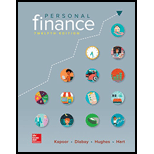
Case summary:
J and R are both 38 years old and their triplets are three and half years old. Now, they are little bit more self-sufficient. They left their children on R’s parent’s home and left for dinner. While on dinner, they started discussing about their futures and future of their children as well. They are thinking that they are going to need $100,000 for college expenses and good amount for their retirement too. The beach house amount may be around $350,000 from thirty years from now which they want to purchase. They decided to talk to investment counselor.
Character in this case: J and R.
Adequate information: Checking account: $4,500
Savings account: $20,000
Emergency fund savings account: $21,000
IRA balance: $32,000
Car: $8,500 (Jamie Lee) and $14,000 (Ross)
Student loan balance: $0
Credit card balance: $4,000
Car loans: $2,000
Jamie Lee: $45,000 gross income ($31,500 net income after taxes)
Ross: $80,000 gross income ($64,500 net income after taxes)
Mortgage: $1,225
Property taxes: $400
Homeowner’s insurance: $200
IRA contribution $300
Utilities: $250
Food: $600
Baby essentials: $200
Gas/maintenance: $275
Credit card payment: $400
Car loan payment: $289
Entertainment: $125
To explain:
Assessing the validity of their financial goal.
Want to see the full answer?
Check out a sample textbook solution
Chapter 13 Solutions
Loose Leaf for Personal Finance
- Hello tutor this is himlton biotech problem.arrow_forwardYan Yan Corp. has a $2,000 par value bond outstanding with a coupon rate of 4.7 percent paid semiannually and 13 years to maturity. The yield to maturity of the bond is 5.05 percent. What is the dollar price of the bond?arrow_forwardA trip goa quesarrow_forward
 Essentials Of InvestmentsFinanceISBN:9781260013924Author:Bodie, Zvi, Kane, Alex, MARCUS, Alan J.Publisher:Mcgraw-hill Education,
Essentials Of InvestmentsFinanceISBN:9781260013924Author:Bodie, Zvi, Kane, Alex, MARCUS, Alan J.Publisher:Mcgraw-hill Education,

 Foundations Of FinanceFinanceISBN:9780134897264Author:KEOWN, Arthur J., Martin, John D., PETTY, J. WilliamPublisher:Pearson,
Foundations Of FinanceFinanceISBN:9780134897264Author:KEOWN, Arthur J., Martin, John D., PETTY, J. WilliamPublisher:Pearson, Fundamentals of Financial Management (MindTap Cou...FinanceISBN:9781337395250Author:Eugene F. Brigham, Joel F. HoustonPublisher:Cengage Learning
Fundamentals of Financial Management (MindTap Cou...FinanceISBN:9781337395250Author:Eugene F. Brigham, Joel F. HoustonPublisher:Cengage Learning Corporate Finance (The Mcgraw-hill/Irwin Series i...FinanceISBN:9780077861759Author:Stephen A. Ross Franco Modigliani Professor of Financial Economics Professor, Randolph W Westerfield Robert R. Dockson Deans Chair in Bus. Admin., Jeffrey Jaffe, Bradford D Jordan ProfessorPublisher:McGraw-Hill Education
Corporate Finance (The Mcgraw-hill/Irwin Series i...FinanceISBN:9780077861759Author:Stephen A. Ross Franco Modigliani Professor of Financial Economics Professor, Randolph W Westerfield Robert R. Dockson Deans Chair in Bus. Admin., Jeffrey Jaffe, Bradford D Jordan ProfessorPublisher:McGraw-Hill Education





